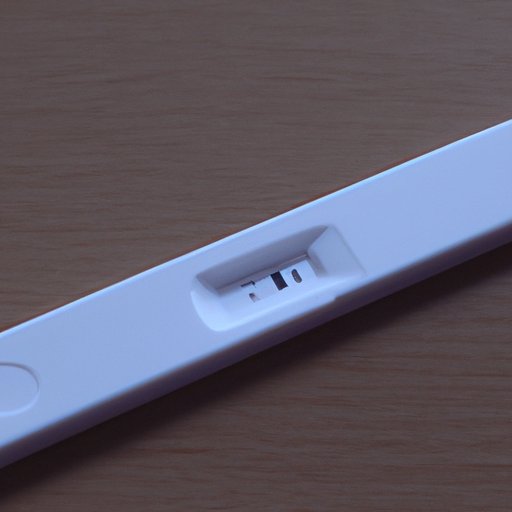Introduction
A pregnancy test is a diagnostic tool used to detect the presence of the hormone hCG in a woman’s urine or blood. This hormone is only produced during pregnancy, so if it is present, it is an indication that a woman is pregnant. Taking a pregnancy test is the most reliable way to determine whether or not a woman is pregnant.
This article provides a comprehensive guide to help women understand the best timing for taking a pregnancy test for the most accurate results. We will look at the advantages and disadvantages of taking a home pregnancy test, as well as how to read the results.

A Comprehensive Guide to Timing Your Pregnancy Test for Accurate Results
When it comes to taking a pregnancy test, timing is everything. Knowing when to take the test can mean the difference between getting accurate results or not. Here is a comprehensive guide to help you get the most accurate results when taking a pregnancy test.
When Is the Best Time to Take a Pregnancy Test?
The best time to take a pregnancy test is when your period is late. This usually occurs around 14 days after ovulation. If you have been trying to conceive and you believe you may be pregnant, you should wait until your period is late before taking a pregnancy test. This will give you the most accurate result.
How Soon After Having Unprotected Sex Can You Take a Pregnancy Test?
If you have had unprotected sex and think you may be pregnant, you should wait at least two weeks before taking a pregnancy test. This is because it takes up to two weeks for the hormone hCG to build up in your body. If you take the test too soon, you may get a false negative result.
The Pros and Cons of Taking a Home Pregnancy Test
Taking a home pregnancy test can be a convenient and cost-effective way to determine whether or not you are pregnant. However, there are some pros and cons to consider before taking a home pregnancy test.
Advantages of Home Tests
One of the main advantages of taking a home pregnancy test is that it is easy to do and requires minimal effort. All you need to do is purchase a test kit at your local pharmacy or online, and follow the instructions. Home tests are also relatively inexpensive and provide quick results.
Disadvantages of Home Tests
One of the main disadvantages of taking a home pregnancy test is that they can be inaccurate. This is because the amount of hCG in your body can vary depending on when you took the test. Additionally, home tests are not as sensitive as laboratory tests, so they may not detect very low levels of hCG.

How to Read the Results of a Pregnancy Test
Understanding how to read the results of a pregnancy test is important for getting an accurate result. Here is what you need to know about interpreting the results of a pregnancy test.
What Do Positive Results Mean?
A positive result on a pregnancy test means that the test detected the presence of the hormone hCG in your body. This indicates that you are pregnant. It is important to note that a positive result does not necessarily mean that you are definitely pregnant. You should talk to your doctor for confirmation.
What Do Negative Results Mean?
A negative result on a pregnancy test means that the test did not detect the hormone hCG in your body. This indicates that you are not pregnant. However, it is important to note that a negative result does not necessarily mean that you are definitely not pregnant. You should speak to your doctor if you have any doubts.
How to Interpret Faint Lines
If you get a faint line on your pregnancy test, it means that the test detected a small amount of hCG in your body. This could indicate that you are pregnant, but it is important to speak to your doctor to confirm the result. A faint line could also be a sign of an early miscarriage.
Conclusion
Knowing when to take a pregnancy test is essential for getting accurate results. The best time to take a pregnancy test is when your period is late, which is usually around 14 days after ovulation. Home pregnancy tests are convenient and cost-effective, but they can be inaccurate. Understanding how to interpret the results of a pregnancy test is important for getting an accurate result. If you get a faint line on your pregnancy test, it could indicate that you are pregnant, but it is important to speak to your doctor to confirm the result.
In conclusion, timing is key when it comes to taking a pregnancy test. If you wait until your period is late, you will have the best chance of getting accurate results. Knowing how to read the results and understanding the pros and cons of taking a home pregnancy test will help you make informed decisions about your health.


